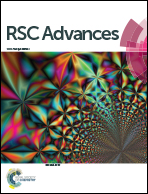Roughening of windmill-shaped spinel Co3O4 microcrystals grown on a flexible metal substrate by a facile surface treatment to enhance their performance in the oxidation of water†
Abstract
High-efficiency and Earth-abundant electrocatalysts for the oxidation of water are required in the production of clean energy from the electrolysis or photolysis of water. Spinel Co3O4 microcrystals with a windmill shape were grown on a flexible metal substrate. The microcrystals were then roughened by a surface impregnation treatment. A secondary nanostructure grew out of the blades of the windmills to form a micro/nano hierarchical structure. The as-grown micro/nano Co3O4 had an excellent electrochemical performance in the oxidation of water. The onset overpotential of the micro/nano Co3O4 electrocatalyst for the oxidation of water was about 0.29 V in alkaline solution and the overpotential of the optimum Co3O4 electrocatalyst was 0.41 V at a current density of 10 mA cm−2. These results suggest that the electrochemical performance is associated with the roughness and active surface of the Co3O4 electrodes. The turnover frequency of the optimized Co3O4 reached 0.39 s−1 at an overpotential of 0.6 V, about 1.4 times higher than that for the pristine Co3O4 microcrystals. The turnover frequency of micro/nano Co3O4 is higher than, or comparable to, that previously reported for high-efficiency nanosized Co3O4 in alkaline solution. Stability tests indicated that these micro/nano Co3O4 electrocatalysts were highly durable towards the oxidation of water, with no structural change and no decrease in noticeable activity after operating for 12 h in oxygen-evolving reactions. This work verifies the contribution of surface roughness and an active surface to the electrochemical oxidation of water by the design of an optimum micro/nano Co3O4 electrocatalyst. Our current understanding of the catalytic role of a specific micro/nano structure is also strengthened.


 Please wait while we load your content...
Please wait while we load your content...